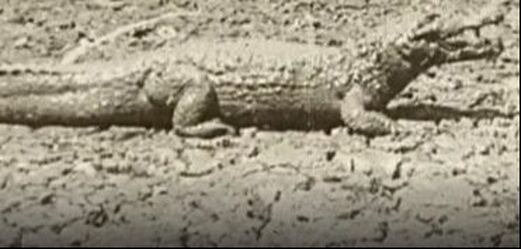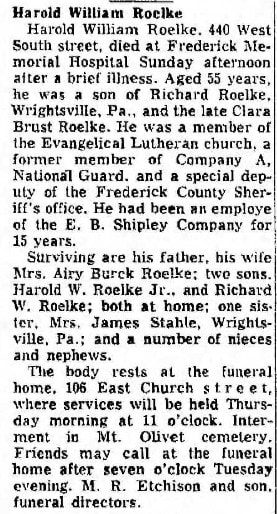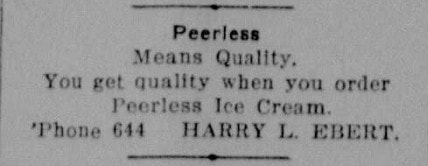|
A few months ago, I stumbled across a tandem of interesting articles in the Frederick News-Post from the fall of 1938 while researching another Story in Stone. These finds featured a most unlikely topic for our “Clustered Spires” home—alligators. Within the clippings retrieved from the paper, I saw that Mount Olivet is the eternal resting place to four leading players in what can be deemed a gold ole-fashioned, reptilian drama. I will tell you about the gator, later. But before I do, I’d like to introduce a few former Fredericktonians to you. I will start with a gentleman, who at the time in question, was working as a fireman and cook at the county jail that once was located in the 400 block of West South Street. This is now the Frederick Rescue Mission. His name was Harold W. “Peck” Roelke, and he lived basically across the street from the old jail and just a few house to the east with his wife, Arittinia Virginia (Burck) Roelke. He was born in Frederick in 1901, the son of Richard and Clara (Brust) Roelke and died in 1956. "Peck" Roelke was a veteran of World War I, and recently received a wreath through the Wreaths Across America program. He is buried in Mount Olivet's Area CC/Lot 99A. You can read more about his life in the obituary below. Another player in this tale of yore was Harry Lucien Ebert. Mr. Ebert lived from 1881-1946, and his name may be recalled in relation to the fine dairy and ice cream establishment he was responsible for creating. He and his wife were laid to rest in Area T/Lot 11, not far from the grave of legendary patriot and Maryland’s first governor, Thomas Johnson, Jr. As a matter of fact, Harry Ebert’s dairy operation was constructed on land that was once part of Johnson’s vast plantation on the north side of the city. The Ebert Dairy and Ice Cream Parlor is long gone as a business, but the structure still stands at 1781 North Market Street, cata-corner from Gov. Thomas Johnson Middle School. Many may recall its use as Letterio’s Italian Restaurant for many years. Since 2011, it’s served as the home of both the Flying Barrel and Monocacy Brewing Company. As for Harry L. Ebert, he resided at 410 South College Parkway in Frederick. In the 1940 US Census, he is living with his wife Mary, brother John, and sister-in-law Mable Dertzbaugh. Since Mr. Ebert’s business plays a role in our story, I want to share a bit more on its history. I’ve been aware of it for quite some time, and have two postcards in my personal collection that illustrate it wonderfully. He started with grocery and confectionary, which became an ice cream parlor. This was located downtown on the corner of Fifth and Market, and later moved to the outskirts along the main road north before there was a US15. In her May 6th, 2018 edition of Preservation Matters for the Frederick News-Post, Christina Martinkosky wrote about the building that many longtime residents knew as the old Ebert’s Dairy Building. “Before the 20th century, farmers consumed much of the milk they produced, with only a portion sold to the nearby community. Ice cream was an inaccessible treat for most people until the mid-19th century, when Nancy Johnson invented the first hand-cranked freezer. By the turn of the 20th century, a new industry emerged, when ice cream production started to shift from the home to local businesses. But distribution was limited, given that the product had to stay frozen throughout its distribution cycle or risk destabilization. The creation of localized milk and ice cream markets in the first quarter of the 20th century coincides with Harry Ebert’s entrance into the industry in 1915. At that time, he was already running a profitable grocery and soda fountain. The new enterprise was branded Peerless Ice Cream and operated out of a 900-square-foot space on the second floor of 505 N. Market St. The business had one employee with an annual payroll of $750. Within the first year, 500 gallons of product were made. Within four years, Harry Ebert was distributing ice cream to some of the largest vendors in Frederick. By the end of the 1920s, the manufactory room at 505 N. Market St. had become inadequate to accommodate further growth. On Dec. 14, 1929, Ebert, along with his two brothers-in-law, Lewis R. Dertzbaugh and Frank M. Dertzbaugh, announced the formation of the Ebert Ice Cream Co. By 1931, Ebert opened the manufactory and dairy bar at 1781 N. Market St., which became one of the largest independently owned ice cream plants in the country. The company employed 45 people to run the plant, which was in operation day and night. When running at full capacity, the manufactory had the ability to produce up to 400 gallons of ice cream per hour. Much of the product was then transported by 10 large refrigerator trucks that delivered within a radius of nearly 60 miles, extending into Virginia, Baltimore and Washington, D.C. The manufactory and dairy bar was an impressive reflection of how significantly the ice cream business had changed since Harry Ebert began his production 15 years earlier. Technological advances and the rise of the automobile changed the way Americans got their ice cream, by taking them out of the ice cream parlors downtown and into roadside eateries on major thoroughfares." In April 1946, after 31 years in the ice cream business, Harry Ebert died at Frederick City Hospital of a heart attack. He is remembered as a founder and president of the Ebert Ice Cream Co. and a pioneer in the ice cream industry. The Ebert family retained ownership of this independent ice cream business until 1961, and the facility continued operations under the Ideal Dairy Co. until 1975, a time when prepackaged ice cream became available through supermarkets and independent manufactories were absorbed into larger businesses. The hero of this week's story was William E. Baer, a resident in the late 1930s of East Sixth Street, 102 to be exact. Mr. Baer is buried in Mount Olivet’s Area SS/Lot 37B. Born in 1920, he was only 18 when the event happened that would put his name in the papers for all the right reasons. In the 1940 census, he is living with his parents (Richard and Josephine Baer) and five siblings. He would pass in 2004 at the age of 84. Mr. Baer's death date of June 13 (2004) resonates with me as he died the day before my father and hero, and both from complications associated with cancer. Finally, I’d like to introduce you to Earl Haines (1908-1981). You can find him in Area LL/lot 65. I had come across Mr. Haines name before as the proprietor of Porter’s Tourist Camp once located on West Patrick Street, a block west of the intersection with Bentz Street. The native Pennsylvanian was assisted by his wife Alberta at their work-home at 503 West Patrick Street. Interestingly, I also have a postcard in my collection depicting Mr. Haines' former business that would be located on the west side of town at the familiar intersection of West Patrick Street and West College Terrace. The lodging for travelers here was started by a man named Herb Porter who sold Earl Haines the business in 1930. I presume the cabins were atop the hill but could have occupied some of the property that makes up Frederick High's football stadium complex. (Please let me know in the comments). Haines also ran a restaurant associated with his former employer (Porter) as well. Now having made proper introductions, I must confess that the true star of the show, once known around town as "Alley," is not buried here in Mount Olivet, but I'm sure you have a good idea for a reason why. I'm not quite sure where he wound up in the end, but I do know that he had quite the adventure in the late summer and fall of 1938. So it appears the newspaper had some fun with the daring escape. Alley was a well-known attraction at the ice cream parlor, not something usually seen in such a place. I have read that small alligators were popular as pets during the time. It was the Great Depression, folks needed an escape. How many Fredericktonians had the opportunity to travel south and see a gator with their own eyes? I found that alligators were living at the White House during the Depression, during Herbert Hoover’s presidency in the early 1930s. Hoover’s younger son, Allan, had two pet alligators that frequented the White House grounds, all the while, amazing and likely terrifying guests. The gators were said to have kept Hoover’s own German shepherd, named King Tut, on edge — not to mention the president’s Secret Service agents! In researching, I'm thinking that our scaly friend received his name because it was an easy play on alligator. However, I also saw that one of the leading newspaper comic strips was that of Alley Oop, a loveable caveman , created by cartoon artist V. T. Hamlin. The following comic appeared about the time of Mr. Ebert's introduction of the Florida native to Frederick. One month later in September (1938), an amazing find by the fore-mentioned "Peck" Roelke drew renewed interest and excitement in the case of the missing reptile. Mr. Ebert may have been happy for his fellow pet-owner Mr. Haines, but the search continued for Alley. As time passed and the seasons changed giving way to colder temperatures, it is likely Mr. Ebert's hopes were waning. Ebert Ice Cream Parlor was booming with the holidays, as was the Plant with its annual Christmas flavors and special "block" (of ice cream) sales. Two days after the day celebrating Jesus' birth, Mr. Ebert received a much unexpected present thanks to the acumen of William E. Baer. A happy ending as Alley was rescued and permitted to "thaw out" at an ice cream plant, which seems like a "just dessert" for the former escapee. As stated earlier, all these players, save the gator, are buried here at Mount Olivet. Some years back, I wrote a story about an alligator hunt thirty years previous. It involved another pet gone rogue in Frederick City's Courthouse Square neighborhood. The two-foot alligator of young Gordon Gaver escaped its domicile at the Urner household, eventually managing to gain entrance to a nearby property on W. Church Street—about fifty yards to the southwest, the home of Mrs. Henrietta Maulsby. A domestic servant got the surprise of a lifetime, finding the gator resting in a coal bin within Mrs. Maulsby’s basement. A police officer was summoned and aided by a young neighbor. The twosome successfully apprehended the sharp-toothed reptile after a three-hour standoff in which the said fugitive hid underneath a wood pile. Unfortunately, the alligator fell prey to vigilante justice as he was clubbed to death. Fifteen year old Gordon learned a tough lesson that night. However, Gordon Gaver (1904-1964) would make a career out of owing and displaying exotic pets as he later opened the Jungleland Serpentarium along US 15 below Thurmont. This would eventually become the Catoctin Mountain Zoo and Wildlife Preserve. Mr. Gaver is buried in Mount Olivet's Area Q/Lot 83. I wanted to wrap up the story with checking on any alligator-inspired gravestones. Although we can't claim any here in Mount Olivet, I did find a unique one in Jacksonville, Florida. It belonged to Joseph "Alligator Joe" Campbell (1872-1926), the originator of alligator farming in America and the owner of the former Florida Alligator Farm in Jacksonville. His unique grave marker can be found in Evergreen Cemetery in Jacksonville. A 2006 River City, FL News article provides the following information about "Alligator Joe:" "Joe's real name was Hubert and he was born in India in 1872, his father a decorated English officer. His passion was alligators and after his Wild West days and a stint of ostrich riding and training, he chose to live in Jacksonville, where, for all his showmanship, he was a well-respected naturalist. Due to the drainage of the Everglades and other state development, 2.5 million alligators were reportedly killed in the 1880s. Commercial hunters and gun-happy tourists helped decrease the population. There seemed to be no better fun than killing gators while cruising on a steamboat. Although Campbell also hunted alligators, because he feared their extinction he merged with Jacksonville's ostrich farm, the best in the country. By adding his gator collection to the lanky menagerie, he could study and breed both species. In 1912, when 200 ostriches strode into their new billet at Phoenix Park, Alligator Joe and his patient pod of gators were already awaiting the bubble-bottomed birds. This lively tourist destination, Florida's original theme park, percolated east of Jacksonville at Talleyrand Avenue, near Evergreen Cemetery and the river. Ostrich racing was a great sport of the era as contemporary ads and postcards indicate. So, to prevent hurt feelings and jealousy, Campbell likewise trained his gators to race and to carry riders. The alligators' education extended to climbing and to waltzing. While the reptiles and ostriches were not competitive, they spent little time together, promoting ostrich longevity. In 1907, the Dixieland Park exposition and resort opened at the ferry landing in South Jacksonville, where Alligator Joe, some ostriches and alligators, together with electric fountains, burros, bands and theater productions, were major attractions. The reptiles climbed ladders, slid down chutes and carted children on their broad, rough backs. Campbell was also becoming famous in the movies and newsreels for his alligator shenanigans and study of the creatures. In 1916, the Ostrich Farm and Alligator Farm, in some queer arc, shifted across the river to South Jacksonville on the site of the Aetna Insurance building, originally Prudential Insurance. Campbell and his wife, Sadie, lived on a houseboat near the southern end of the future Main Street Bridge." In later years, Campbell wrote a pamphlet about alligators, which included explanations of his life and work. His early gator farming was in Palm Beach, Arkansas and California. By the time he developed his Jacksonville enterprise, hoping to discourage their cannibalistic tendencies, he separated his alligators by size into pens of 200 head, numbering in the thousands. Alligator Joe died in 1926 at the age 53. His life story is certainly captured in stone.
1 Comment
MaryAnn Eader Turney
1/24/2023 10:49:14 pm
Our friend, Ed Mull, also had a pet alligator. 🐊
Reply
Leave a Reply. |
STORIES
|
Archives
July 2024
June 2024
May 2024
April 2024
March 2024
February 2024
January 2024
December 2023
November 2023
September 2023
August 2023
July 2023
June 2023
May 2023
April 2023
March 2023
February 2023
January 2023
December 2022
November 2022
October 2022
September 2022
August 2022
July 2022
June 2022
May 2022
April 2022
March 2022
February 2022
January 2022
December 2021
November 2021
October 2021
September 2021
August 2021
July 2021
June 2021
May 2021
April 2021
March 2021
February 2021
January 2021
December 2020
November 2020
October 2020
September 2020
August 2020
July 2020
June 2020
May 2020
April 2020
March 2020
February 2020
January 2020
December 2019
November 2019
October 2019
September 2019
August 2019
July 2019
June 2019
May 2019
April 2019
March 2019
February 2019
January 2019
December 2018
November 2018
October 2018
September 2018
August 2018
July 2018
June 2018
May 2018
April 2018
March 2018
February 2018
January 2018
December 2017
November 2017
October 2017
September 2017
August 2017
July 2017
June 2017
May 2017
April 2017
March 2017
February 2017
January 2017
December 2016
November 2016











































 RSS Feed
RSS Feed